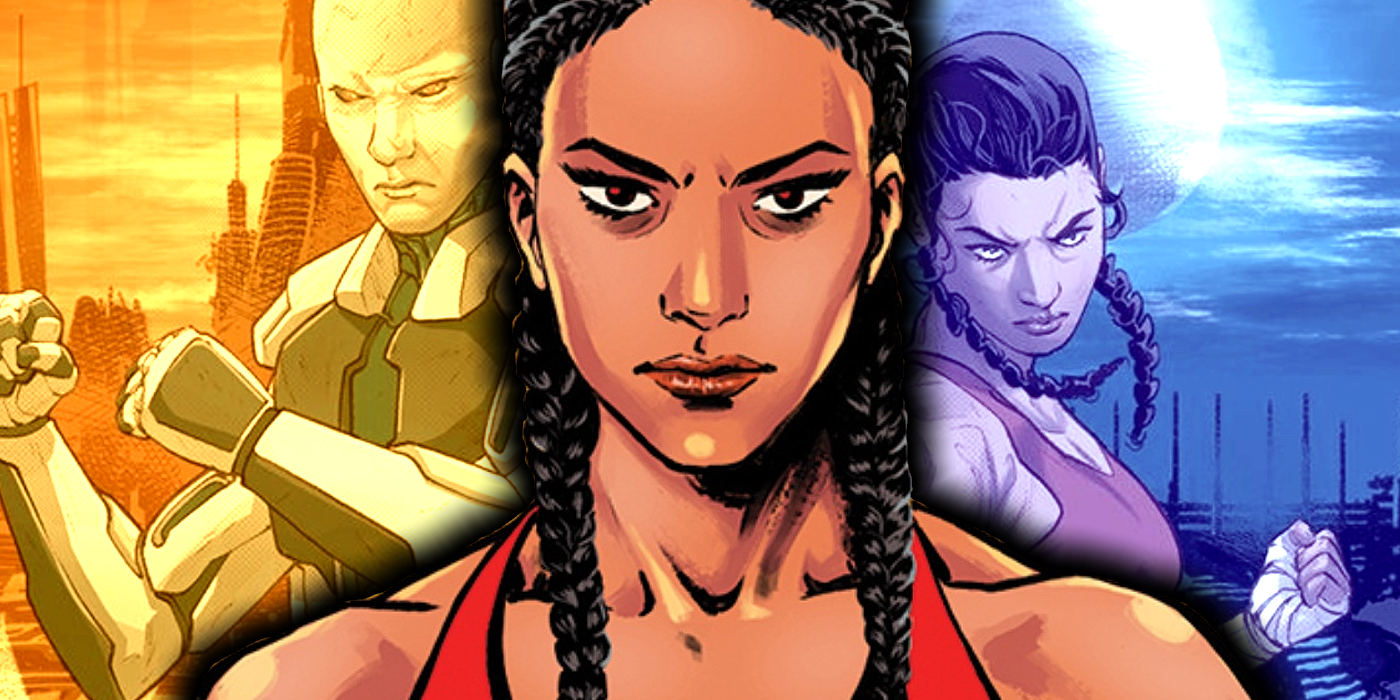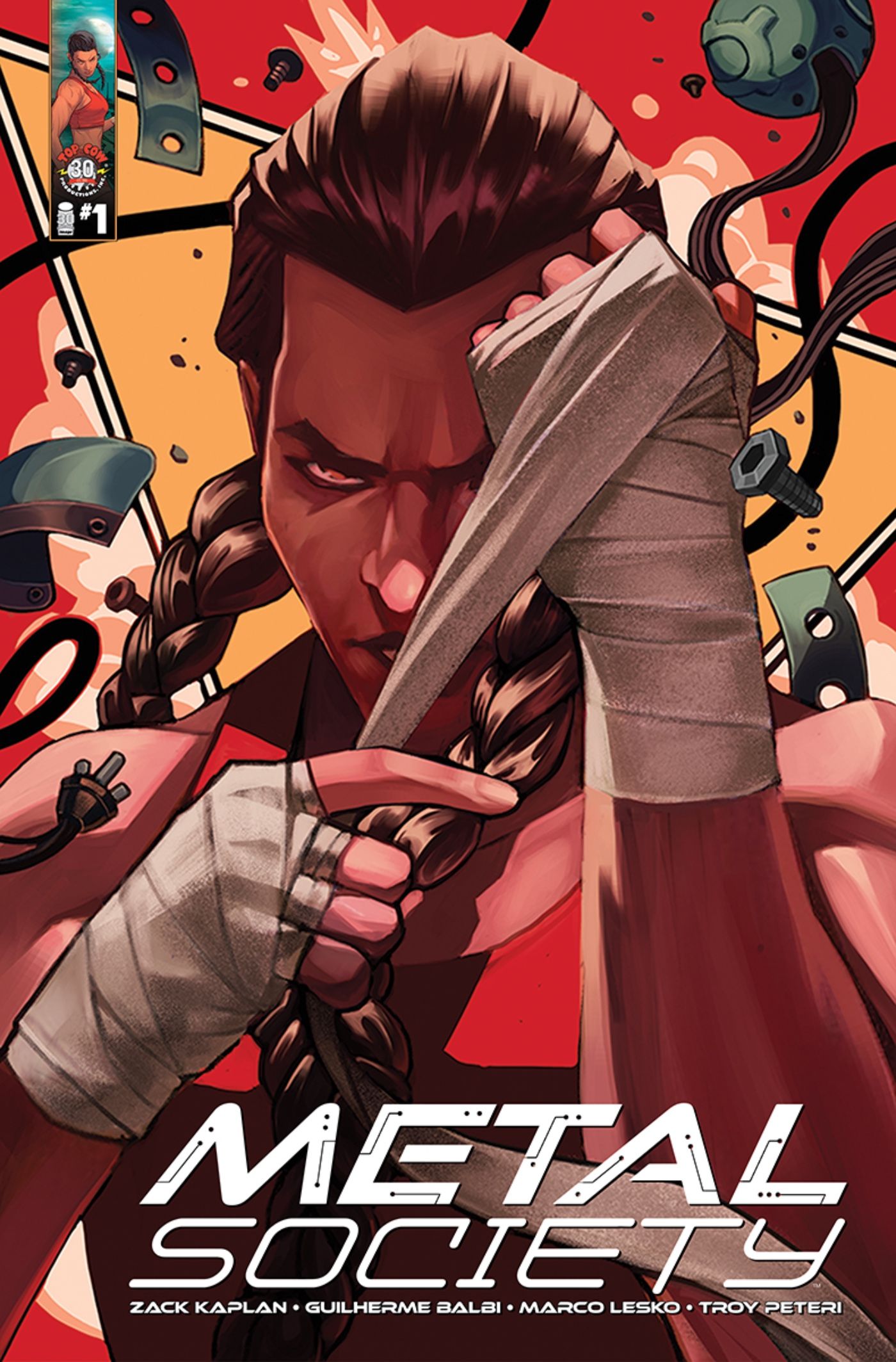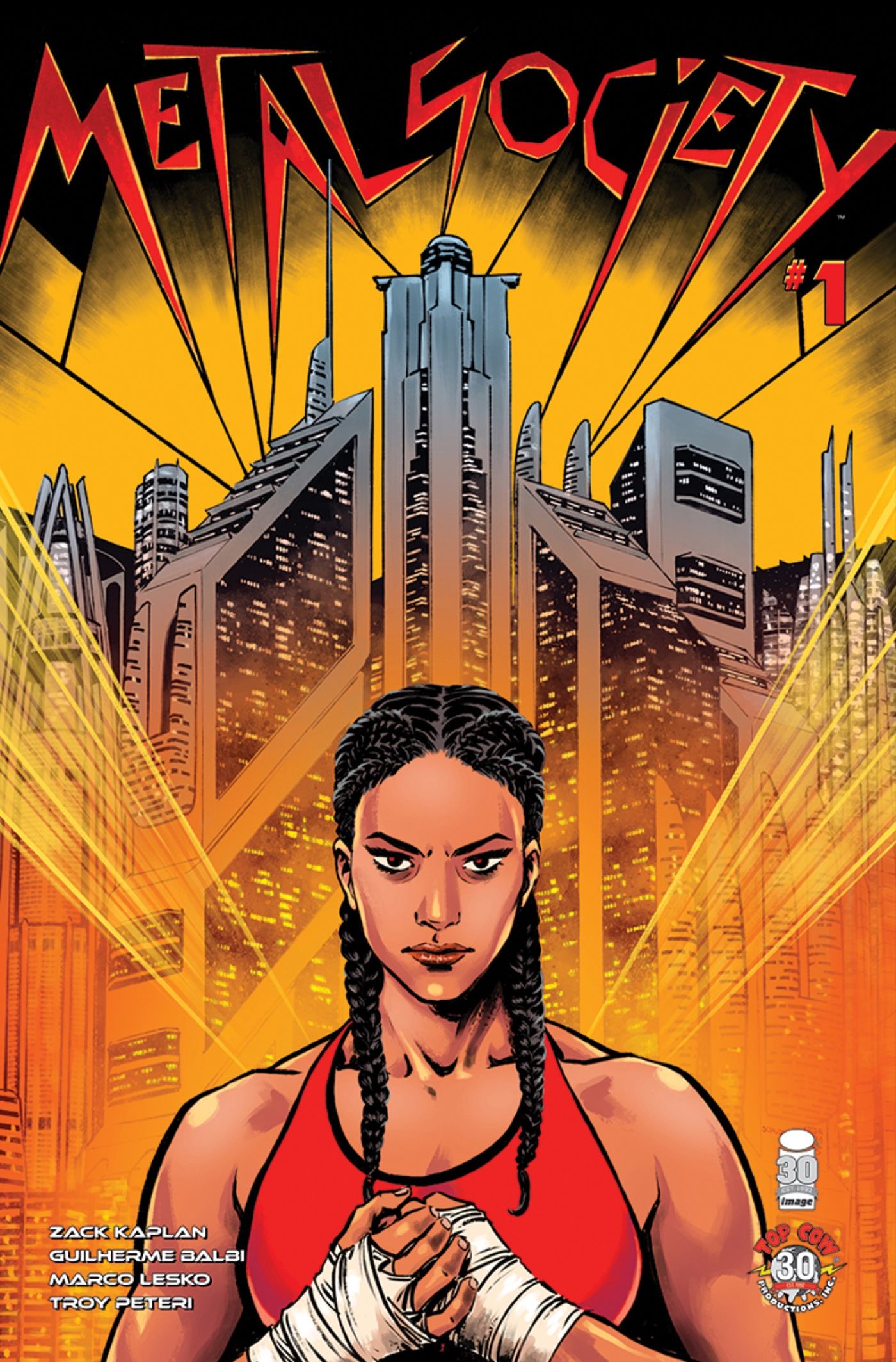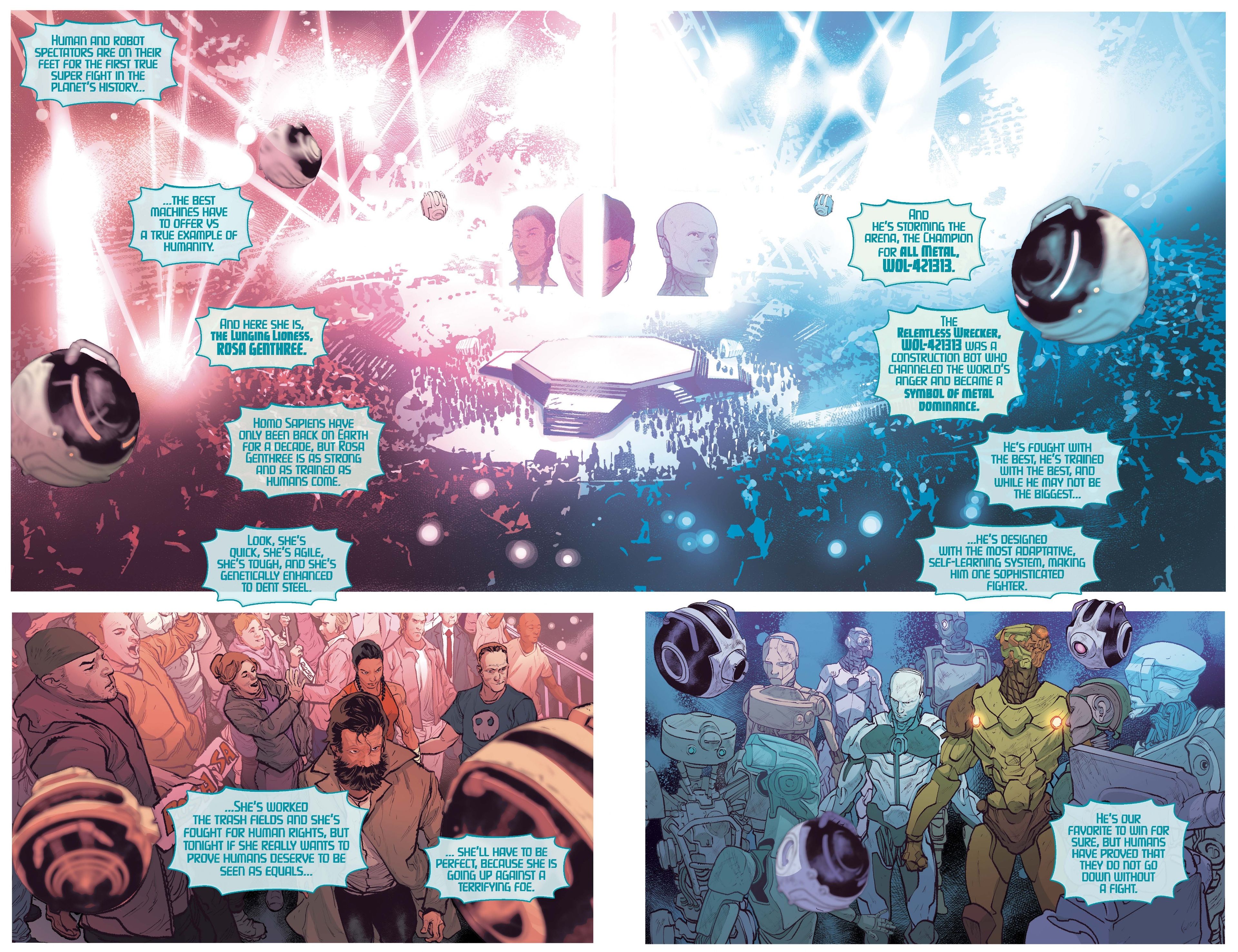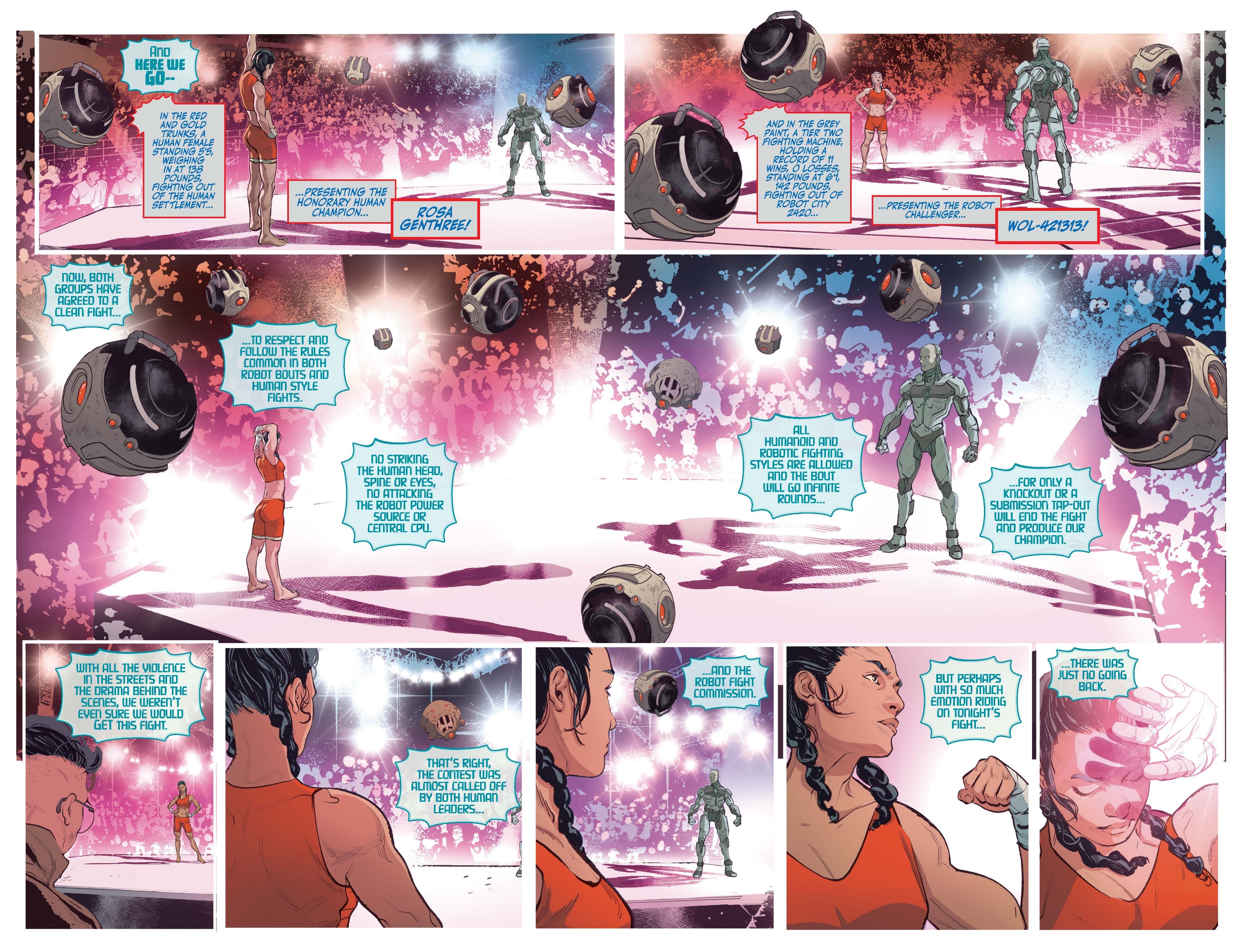Warning: potential spoilers for Metal Society #1 ahead!
On May 4, Image Comics' Top Cow imprint will unveil Metal Society, a unique spin on the classic science fiction trope of humans fighting robots. In the distant future, humans have gone extinct, but are revived by robots to work as a labor class. Humans, resentful of their status, have begun rebelling, leading to an epic, zeitgeist-defining fight; but instead of fighting on battlefields, the humans and robots will be duking it out in a cage.
This unique take on a tried and true story will be written by Zack Kaplan, drawn by Guilherme Balbi, colored by Marco Lesko and lettered by Troy Peteri. Metal Society writer Zack Kaplan answered some questions for Screen Rant about the new series, offering insight into its origins and what fans can expect.
The idea of humans in conflict with robots is a classic science fiction trope, going back at least a century. Metal Society puts a very unique spin on this concept - by pitting humans and robots in actual physical fights. What led you to frame the story in such a unique way?
Zack Kaplan: There’s that joke – is a robot gonna take my job? As our society currently embraces automation and technology and AI, I think there's an often almost humorous discussion about our fear that robots will one day replace us. But I think there is a very real paranoia. So, I initially became interested in a world of robots fearing humans replacing their work as a twist on this idea, and a sort of way to explore a robot story in a new way. I think we often see robot stories about robots trying to heartlessly dominate or destroy or enslave humans. But I was more interested in exploring a metaphor for how we as humans fear each other, and the divisions that currently exist in our world. So, by making the robots human in nature, I found that allegory that allowed the robots to fear us.
But I didn’t have the actual framework for the fight until I saw the Conor McGregor/Khabib Nurmagomedov UFC bout in 2019 and I learned it was a symbolic clash between the Chechen and Dagestan people and Putin’s Russia. Not only had there been war between Russia and these provinces, but the rhetoric had spilled over into this very fight, with Khabib fighting for his homeland, and McGregor supporting Putin. That was when I realized a simple fight drama could have epic symbolic implications. That was when Metal Society became a story about a human fighter and a robot battling out global stakes in the ring. I think we’ve seen a couple robot boxing fights before, but this allowed me to really inject a modern perspective that explored tribalism and tragic social divisions.
I think those that have read my past work, especially some of my other hard sci-fi, such as Port of Earth with Image/Top Cow or Join the Future with Aftershock, know that I like to explore complex worlds in flux and how those power struggles affect ordinary people.
Looking at the variant covers for Metal Society’s first issue, there was one that was clearly a riff on the Fritz Lang classic Metropolis. As another story pitting humans against robots, it fits very well. Are there other science fiction books/films/television shows that have informed Metal Society?
Zack Kaplan: You know, I’m a big fan of research, but I couldn’t find too many films or TV shows about future worlds of robot societies with humans in this way. Usually, stories seem to be focused on total human v robot war, or perhaps the origins of robot AI, or humans mistreating robots. Obviously, aesthetically, I looked at Blade Runner as a dystopian future and visual touchstone. But I actually spent a lot of time exploring fight dramas like Rocky or Creed or Warrior. As Metal Society actually follows the storylines of both the human and robot fighter, I gravitated towards dual protagonist sports dramas like Rush or HBO’s Borg v McEnroe. That was a really good one. Those were all just as provocative as the sci-fi touchstones. I found it interesting that many sports dramas frame the competitors as head v heart, and obviously that works nicely in this robot v human setup. The role of the coach, the sports montage, the high stakes social response – all of this helped to infuse an authentic fight drama into an already provocative sci-fi world of robots and futurism.
Rosa Genthree, Metal Society’s protagonist, trains extensively. Did this require research into boxing and fighting techniques?
Zack Kaplan: It sure did. I watched a lot of MMA fights and learned a lot about different techniques. But at the end of the day, I found it less important to the narrative. I’m sure a lot of those details come out in small ways, and that will help to make a more authentic story. Certainly, the two fighters have different coaches and different locations they train, so that helps to see the way real fighters train differently. But truth be told, the story is not about which fight combo will bring down an opponent. Any good fight drama is really about the heart of a champion and the drama of facing the pressure of a big fight. The exciting layer here is that Rosa is fighting two fights. One, she’s trying to defeat an indomitable opponent to show that humans have a place in robot society. But she’s also trying not to alienate robot society and push robots and humans to further devolve into tribalistic reactions.
Along similar lines, did you have to do any research into robotics for this series?
Zack Kaplan: Actually no. I mean, Guilherme and I spent a tremendous amount of time discussing the visual look of these robots. We wanted them to feel different, so there are lots of different looks. This society sees the function of a robot as very important, and so each robot has a different job, and therefore a different look. And while the robots are acting human in many ways, we didn’t want them wearing human skin or clothing or having hair. They are proud to be metal and to be robots, even though they are also simultaneously living in the fashion of their creators. So, I think we put a lot of thought into the dynamics of robots. One funny aspect of the world that feels oddly normal is the robots have developed media and entertainment as a way of sharing information. They have talk shows and radio shows and they listen to the information and they form opinions. There is a natural acceptance that robots will act human in some ways and robotic in others. I think it was important to create a world that follows clear rules about how the robots will be robotic at some points, but human at others. This is all to say I found the spectrum of a robot to be very versatile, and rather than get bogged down in the research, I focused on the Metal Society robot design.
An important aspect of sci-fi is world-building and there is an incredible amount of it running through Metal Society. The first issue’s script does a good job of bringing readers up to speed quickly on this intriguing new world. There is a lot going on in the first issue – can readers expect to see more of this new society?
Zack Kaplan: Oh yes, there are a lot of layers to the world of Metal Society and as the characters go through their journey and as we go through the issues, we definitely see more and more world-building. My approach to world design is to really map it out a great deal, but then sprinkle it all in throughout the story. There are throwaway lines about the robot past that reveal a great amount of scale to this world. I think at one point a robot talks about Robot Unity wars. There is another point where we see how robots make societal decisions. We meet the human ruling body. We see robot media. All of it is done as new conflicts emerge and bring Rosa and her competitor WOL closer towards fight night. I think at the end of the day, it’s a rich and complex world, two worlds really, with the robot upstairs world and the human downstairs world, but I think readers will enjoy the mystery and journey of learning more about all of these layers to Metal Society.
What have your experiences working with Image Comics and Top Cow been like? I noticed Metal Society is not your first Image title. What about Image is a draw for you?
Zack Kaplan: Image Comics is a fantastic publisher that offers creators a real platform to take chances. And Top Cow is the imprint I’ve worked with on all three of my Image series, Eclipse, Port of Earth and now Metal Society. Over the years, Top Cow has really developed an identity for having great sci-fi and we’ve developed a good partnership for these sorts of series. Top Cow and Image both really support our vision and allow the creative team to do what we do best, which is create something awesome and inventive. But often times, as a creator, you’re pitching an idea to a publisher, and you’re just hoping the publisher is attracted to it enough, that it doesn’t just fit their slate but that it’s something they can be passionate about. Top Cow has been passionately behind Metal Society. In fact, Marc Silvestri, Top Cow’s founder and one of the best comic artists of this generation, drew a variant cover for Metal Society; and we were lucky enough to get famed Mexican colorist Alex Sinclair to color it. For comic readers and Silvestri/Sinclair fans, this was an exciting collaboration and it goes to show the support and energy the publisher poured into this.
Artist Guilherme Balbi is an up and coming artist, and his art shines in the first issue. How did Balbi come to be involved with Metal Society? What has it been like working with him?
Zack Kaplan: Sometimes a comic series comes together with the art team first, but in this case, I had shared the idea with Matt Hawkins and Elena Salcedo at Top Cow, and they just loved it. We knew we needed an artist who could capture this sci-fi world but also strong character work for a very willful heroine. Guilherme was relatively new to comics, and already a rising star. He had done sci-fi work on Aliens and Avatar at Dark Horse, and his style was really perfect. We collaborated very heavily, talking out layouts, exchanging ideas on the world. It was a very tricky and ambitious process because there are a lot of layers to this narrative. There’s world-building. There’s the sci-fi aesthetic. And then dual protagonist storylines in non-linear fashion requires us to communicate a lot about each moment for the characters. But Guilherme brings a never-ending enthusiasm and a love for comics. He's a very passionate and supportive artist and it’s been a joy to work with him.
Likewise, colorist Marco Lesko and letterer Troy Peteri really enhance the issue with their contributions. What was it like working with them?
Zack Kaplan: We connected with Marco Lesko because he was coloring Blade Runner over at Titan Comics, and it was a great style for Metal Society. We needed something that was sci-fi and dystopian and would capture the grittiness to this world. Not to mention the robot world and human world had a lot of variation. Marco nailed it, of course. The same ambitious assignment was before the letterer. How do we represent human voices and robot voices? The robots are all different, does that mean the robot bubbles are different? And there’s sports announcers as well. It was an undertaking and Troy was able to bring a level of creativity and strategy to all if it. It’s really quite impressive.
Metal Society gets off to a roaring start, mixing action and world-building. What can readers expect from the book over the remaining four issues?
Zack Kaplan: I would say character drama and very tense stakes. The sci-fi world-building is constant and of course we are building towards a climatic finale where the fight will unfold and we’ll get to see what happens. But the ride in between is really more about the buildup to the fight, and what it reveals about this world. And as those revelations come to be, I think the characters find themselves incredibly pressured. It’s a very volatile and energetic build up! But this is not a story about a fighter doing a lot of fights. This is a fight drama about two fighters preparing for a single fight of global stakes, and a fight loss that will ultimately sentence humanity to permanent inferior manual labor, or a victory that will shatter the robot supremacy across the globe, for better or worse. So, I hope readers come in excited about the world, but fall in love with the characters, especially Rosa, our heroine, because she’s one of the strongest women I’ve ever written, she just embodies every moment of the story and I can’t wait for readers to experience her journey.
Any final thoughts on Metal Society you would like to share with our readers?
Zack Kaplan: I would also just say for those who know my work, especially my hard sci-fi, such as Port of Earth or Eclipse or Join the Future, I like a good slow burn, I like lots of twists and I like complicated dilemmas that have no easy answers. So, dive into Issue #1 for an exciting debut, stick around for some real gut-wrenching drama and stakes, and lots of Rosa facing insurmountable odds, and I promise the finale will be a knockout.
Metal Society, from Image Comics, is on physical and digital sale May 4.

